Having a strong and reliable weld, is fundamental for effective, high quality industrial fabrication. However, the best welding process to use for a given project will depend on a number of different factors like the type of materials being welded, the weld position, project timeline, welder skill, and other variables. One effective welding process for many types of industrial fabrication is GMAW Pulse, also commonly referred to as GMAW-P. Let’s take a closer look at how GMAW Pulse works and the role it plays in industrial fabrication.
Traditional Gas Metal Arc Welding Techniques
Pulsed gas metal arc welding, or GMAW-P, is a modified version of the spray transfer mode. Regular GMAW procedures use a stable electric arc between the electrode and the metal. The molten metal is then vaporized into steam using a high voltage and current to reduce splatter and create a near-perfect weld finish. Since this process utilizes a high amount of voltage, there will be an enormous output of heat and a large weld pool. This means that basic GMAW is not suitable for all welds, especially if the weld involves thinner or lower-quality metals.
The Difference GMAW Pulse Makes
GMAW Pulse strives to solve the issues that can arise from the basic version of the GMAW process. GMAW-P alternates electrical pulses between high and low current up to 400 times per second. After each pulse, tiny droplets of molten metal will fall from the electrode onto the work surface, minimizing splatter and eliminating the need for high amounts of heat. Since there is no need to employ blistering temperatures, the weld pool will be noticeably smaller. This also allows the welder to weld in almost any position.
Impact on Lightweight Metal Welding
GMAW Pulse was originally used to weld lightweight metals, primarily aluminum. Aluminum is highly valued in the industrial world due to its light weight, conductive properties, and resistance to corrosion. However, as valuable as these traits might be, aluminum’s conductive properties also make it difficult to weld and fabricate with other metals, meaning that extremely high temperatures will have to be used. GMAW-P eliminates these issues by offering more extensive weld pool control and preventing burn-through.
Much like aluminum, stainless steel has traditionally been viewed as a difficult metal. Its high tensile strength allows it to stand up to even the toughest external conditions and temperatures. Stainless steel does not flow well, and is prone to warping during the welding process. GMAW Pulse allows for a higher degree of control over the weld pool of this difficult metal, making it more suitable for fabrication.
The Limitations of GMAW Pulse
As with any welding process, GMAW pulse does have some disadvantages and limitations as well. Some of these include:
- GMAW Pulse has higher equipment costs stemming from more complexity.
- GMAW Pulse requires the use of expensive argon-based gas for shielding.
- GMAW Pulse cannot be used outdoors or in drafty areas.
- GMAW Pulse is more prone to contamination than non-pulse GMAW.
- GMAW Pulse is less portable than many other welding processes.
GMAW Pulse Produces Strong and Reliable Welds
Here at STI Group, we understand that GMAW-P can be a rigorous and challenging process, so we strive to provide our clients with the best welding processes available. Our welds are subjected to a series of thorough and intensive tests to ensure that they only produce flawless, high-quality welds. GMAW Pulse produces very strong, reliable welds and offers a great degree of flexibility in terms of the metals it can weld and the positions in which it can be used. However, it is not ideal for every project. With STI Group you can always count on us to provide top quality industrial fabrication regardless of the weld process used.

